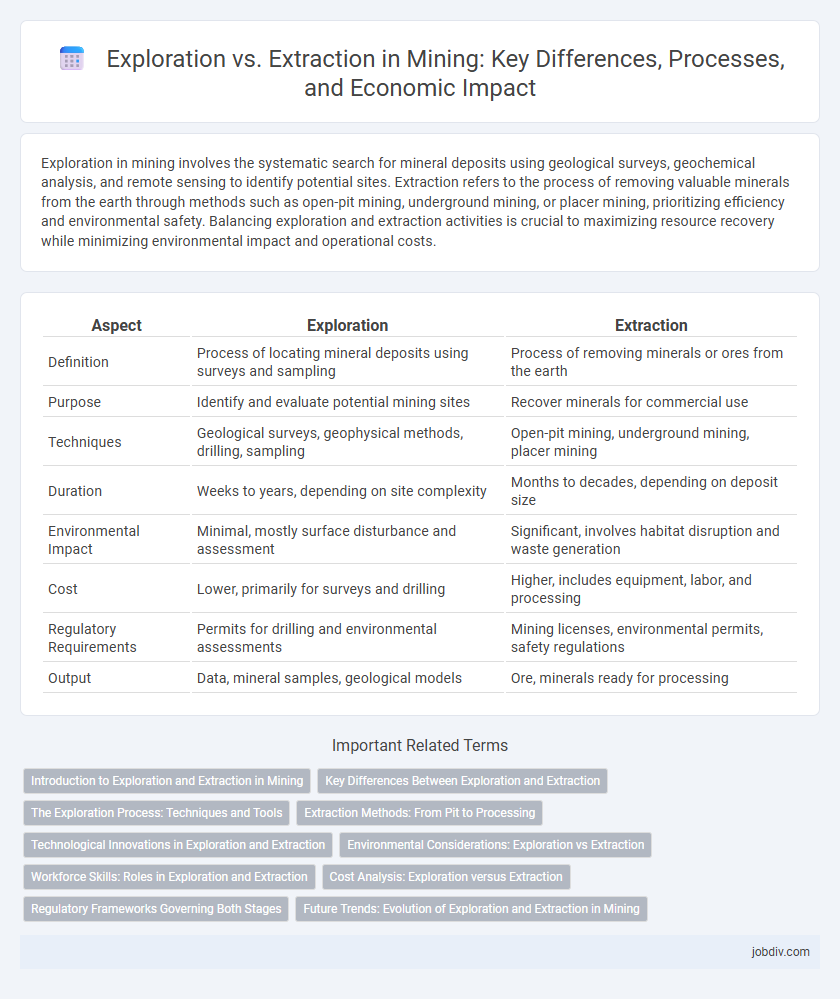Exploration in mining involves the systematic search for mineral deposits using geological surveys, geochemical analysis, and remote sensing to identify potential sites. Extraction refers to the process of removing valuable minerals from the earth through methods such as open-pit mining, underground mining, or placer mining, prioritizing efficiency and environmental safety. Balancing exploration and extraction activities is crucial to maximizing resource recovery while minimizing environmental impact and operational costs.
Table of Comparison
| Aspect | Exploration | Extraction |
|---|---|---|
| Definition | Process of locating mineral deposits using surveys and sampling | Process of removing minerals or ores from the earth |
| Purpose | Identify and evaluate potential mining sites | Recover minerals for commercial use |
| Techniques | Geological surveys, geophysical methods, drilling, sampling | Open-pit mining, underground mining, placer mining |
| Duration | Weeks to years, depending on site complexity | Months to decades, depending on deposit size |
| Environmental Impact | Minimal, mostly surface disturbance and assessment | Significant, involves habitat disruption and waste generation |
| Cost | Lower, primarily for surveys and drilling | Higher, includes equipment, labor, and processing |
| Regulatory Requirements | Permits for drilling and environmental assessments | Mining licenses, environmental permits, safety regulations |
| Output | Data, mineral samples, geological models | Ore, minerals ready for processing |
Introduction to Exploration and Extraction in Mining
Exploration in mining involves the systematic search for mineral deposits through geological surveys, sampling, and geophysical methods to identify economically viable resources. Extraction focuses on the actual removal of these minerals from the earth, utilizing techniques such as open-pit mining, underground mining, and drilling to recover valuable ores efficiently. Both stages are crucial, with exploration providing the data necessary to plan effective extraction and maximize resource yield.
Key Differences Between Exploration and Extraction
Exploration in mining involves geological surveys, sampling, and analysis to identify mineral deposits, while extraction refers to the actual removal of minerals from the earth. Exploration focuses on assessing the quantity, quality, and location of resources, whereas extraction emphasizes operational processes such as drilling, blasting, and material handling. Exploration is a preliminary phase requiring advanced data modeling and geophysical techniques, whereas extraction demands heavy machinery and environmental management practices.
The Exploration Process: Techniques and Tools
The exploration process in mining relies on advanced techniques such as geophysical surveys, geochemical analysis, and remote sensing to identify potential mineral deposits. Tools like ground-penetrating radar, seismic reflection, and drone-assisted mapping enhance accuracy by detecting subsurface anomalies and mineral concentrations. These technologies optimize resource estimation and reduce environmental impact by targeting precise locations for further extraction activities.
Extraction Methods: From Pit to Processing
Extraction methods in mining transform raw ore from open-pit or underground mines into valuable minerals using crushing, grinding, and beneficiation techniques. Open-pit mining involves removing large quantities of overburden to access ore deposits, followed by drilling, blasting, and hauling to processing plants. Advanced processing methods such as flotation, leaching, and smelting enable the recovery of metals like gold, copper, and iron with increased efficiency and environmental control.
Technological Innovations in Exploration and Extraction
Technological innovations in mining exploration include advanced geophysical imaging, drone surveys, and AI-driven data analysis, which significantly enhance the accuracy of identifying mineral deposits. In extraction, automated machinery, real-time monitoring systems, and robotic drilling improve efficiency, safety, and environmental impact management. Integrating these technologies accelerates the transition from exploration to extraction while optimizing resource recovery and reducing operational costs.
Environmental Considerations: Exploration vs Extraction
Environmental considerations in mining differ substantially between exploration and extraction phases. Exploration typically involves non-invasive techniques such as geophysical surveys and sampling, minimizing landscape disturbance and reducing habitat disruption. In contrast, extraction causes significant environmental impacts including deforestation, soil erosion, water contamination, and biodiversity loss, necessitating rigorous mitigation measures and reclamation plans.
Workforce Skills: Roles in Exploration and Extraction
The mining workforce requires distinct skill sets for exploration and extraction phases, with exploration roles emphasizing geologists, surveyors, and data analysts skilled in geological modeling and remote sensing technologies. Extraction roles demand experienced engineers, equipment operators, and safety specialists proficient in mine planning, machinery operation, and compliance with environmental and safety regulations. Continuous training and cross-disciplinary knowledge are essential to optimize productivity and reduce hazards during both exploration and extraction activities.
Cost Analysis: Exploration versus Extraction
Exploration and extraction represent distinct phases in mining with significantly different cost structures; exploration involves high upfront investment in geological surveys, drilling, and data analysis to identify viable ore deposits, often without guaranteed returns. Extraction costs are driven by operational expenses including labor, equipment maintenance, energy consumption, and environmental compliance, which scale with the volume of material removed. Detailed cost analysis reveals exploration expenses carry higher risk and uncertainty, while extraction incurs consistent, predictable expenditures tied to production efficiency and resource depletion.
Regulatory Frameworks Governing Both Stages
Regulatory frameworks governing mining exploration and extraction are distinct yet interconnected, with exploration primarily regulated to ensure environmental assessments, permits for geological surveys, and land access rights. Extraction involves stricter compliance measures, including detailed environmental impact assessments, operational permits, safety standards, and resource management plans. Both stages are subject to government oversight, often requiring adherence to national mining laws, environmental protection statutes, and local community engagement protocols.
Future Trends: Evolution of Exploration and Extraction in Mining
Future trends in mining emphasize the integration of advanced technologies such as artificial intelligence, drone surveying, and remote sensing to enhance exploration accuracy and reduce environmental impact. Autonomous extraction machinery and real-time data analytics enable efficient resource recovery while minimizing operational costs and safety risks. Sustainable practices and digital transformation drive the evolution of exploration and extraction processes, ensuring optimized resource management and compliance with stringent environmental regulations.
Exploration vs Extraction Infographic

 jobdiv.com
jobdiv.com